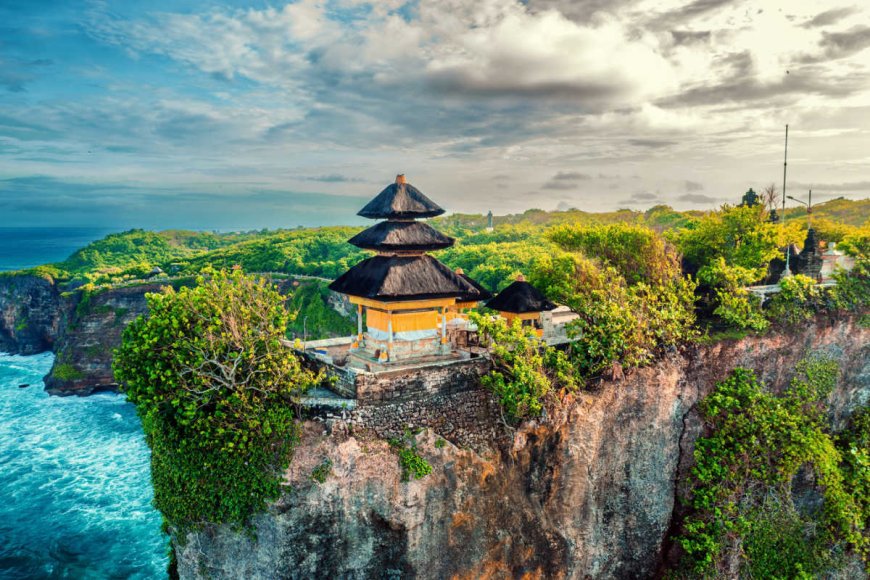Uluwatu Temple: Bali’s Cliffside Gem with Ocean and Culture
Uluwatu Temple is one of Bali’s most stunning and culturally rich destinations. Perched on top of a high cliff in the island’s southern region, this sacred sea temple offers breathtaking views of the Indian Ocean, unforgettable sunsets, and deep spiritual significance.

Uluwatu Temple is one of Balis most stunning and culturally rich destinations. Perched on top of a high cliff in the islands southern region, this sacred sea temple offers breathtaking views of the Indian Ocean, unforgettable sunsets, and deep spiritual significance. Known locally as Pura Luhur Uluwatu, this temple is not just a beautiful tourist spotit is a place of history, tradition, and deep religious importance to the Balinese Hindu community. When you visit Uluwatu Temple, you're not just admiring a pretty view; you're stepping into centuries of Balinese culture and myth.
What draws many travelers to Uluwatu Temple is its dramatic location. The temple sits about 70 meters above sea level, overlooking powerful ocean waves crashing into the cliffs below. As you walk along the edge, following the narrow stone paths that wrap around the temple, you feel the strength of the wind and the endless rhythm of the sea. It's easy to feel small and in awe when you're here, surrounded by nature's beauty and the quiet reverence of a place built to honor the divine. The entire scene feels like something out of a painting, especially at sunset, when the sky turns gold, orange, and deep purple over the vast ocean.
A Place Steeped in History and Belief
Uluwatu Temple is believed to have been built in the 11th century by a Javanese priest named Empu Kuturan, and later expanded by another holy man, Dang Hyang Nirartha. According to legend, Nirartha reached enlightenment here and disappeared into the spiritual realm, which is why the site is considered so sacred. Today, it remains one of Balis six most important sea temples, positioned to guard the island from evil spirits that might come from the sea. Local people continue to visit the temple regularly for prayer and ceremonies, especially during major religious festivals.
Although most of the temples inner areas are restricted to worshippers only, visitors can still explore the outer sections and enjoy the surrounding grounds. The architecture is beautiful, featuring traditional Balinese stone carvings and ornate gateways. As you walk, youll likely encounter the famous long-tailed macaques that live around the temple. These monkeys are known for their playfuland sometimes mischievousbehavior, so hold on to your sunglasses, hats, and phones! While theyre part of the experience, it's always best to keep a respectful distance.
Sunset Views and the Kecak Dance
One of the best times to visit Uluwatu Temple is in the late afternoon, when you can stay to watch the sunset. The combination of the temples silhouette, the glowing sky, and the sound of waves crashing below makes for a magical experience. Many travelers describe the Uluwatu Temple sunset as one of the most beautiful moments of their trip to Bali. Its no surprise that photographers, couples, and nature lovers all gather here each evening to soak in the view.
Just after sunset, you can also watch the famous Kecak fire dance, performed at an open-air amphitheater right next to the temple. This traditional Balinese dance is based on the Hindu epic Ramayana, and it features powerful chanting, dramatic movements, and a captivating fire display. Performed by a circle of men chanting cak, cak, cak, the performance is both spiritual and theatrical. The dance adds a whole new layer to your temple visit, making it more than just a sightseeing stopit becomes an immersive cultural experience that stays with you long after you leave.
How to Visit and What to Expect
Getting to Uluwatu Temple is quite easy if youre staying in popular areas like Kuta, Seminyak, or Jimbaran. You can hire a driver, join a guided tour, or rent a scooter if youre comfortable navigating Balis roads. Entrance to the temple involves a small fee, which includes the use of a sarong and sashtraditional garments required for respectful entry. The temple is open daily, usually from early morning until around 7 PM, but the best time to go is between 4 PM and 6 PM for the sunset and dance performance.
Make sure to wear comfortable shoes, as the pathways around the cliffs can be uneven. Bring a water bottle, sunscreen, and a camerabut be careful with loose items, especially if monkeys are nearby. Its a good idea to arrive a bit early to find a good viewing spot for both the sunset and the Kecak dance. Also, if youre visiting during a festival or religious event, expect larger crowds but also a chance to witness authentic ceremonies and local offerings.
Why Uluwatu Temple Is a Must-Visit in Bali
There are many temples in Bali, but Uluwatu Temple is truly one of a kind. Its cliffside location, cultural significance, and dramatic atmosphere make it an essential stop for any traveler. It offers the chance to step into Balis spiritual world, surrounded by nature and tradition. Whether you come for the ocean views, the cultural performance, or the peaceful energy of the temple grounds, the experience is likely to leave a lasting impression.
The temple also reminds visitors that Bali is not just about beaches and resortsits a place where ancient beliefs still shape daily life. As tourism continues to grow, Uluwatu Temple stands as a symbol of how culture and nature can come together in perfect harmony. Youll leave feeling inspired, grounded, and maybe even a little more connected to the world around you.
So if you're planning a trip to Bali, dont miss the chance to witness one of the islands most powerful and picturesque locations. Whether you go for the sunset, the culture, or just to feel the sea breeze on your face, a visit to Uluwatu Temple is one of the most rewarding experiences Bali has to offer.




























